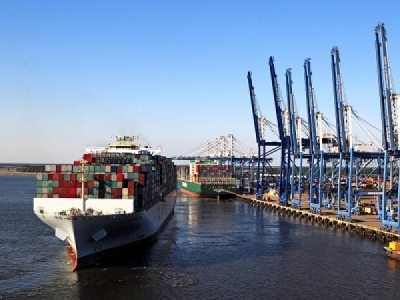
Posted on June 19, 2018
By David Wren, The Post and Courier
When the Army Corps of Engineers was trying to figure out whether it would be beneficial to dig Charleston Harbor to a 52-foot depth, it hired consulting firm Global Insight to forecast how fast containerized cargo will grow at the Port of Charleston in coming years.
After running the numbers, Global Insight predicted the port would handle 2.3 million cargo containers in 2022.
In reality, the port handled nearly that many cargo boxes last year — five years ahead of Global Insights’ projections — and will likely surpass the total in 2018.
“We have pretty significantly overachieved our volume totals,” said Jim Newsome, CEO of the State Ports Authority.
Which is one of the reasons South Carolina officials are calling on the Army Corps to revise the mathematical formula — called a benefit-to-cost ratio — that determines how much money the federal government sets aside each year to help pay for the $558 million dredging project, which will give Charleston the deepest waterway on the East Coast.
The initiative is part of the SPA’s plan to lure more of the big container ships now traveling through the Panama Canal to East Coast ports.
Based in part on the Global Insight projections back in 2011, along with a slew of other predictions that have proven to underestimate the port’s record-breaking growth, the Army Corps assigned a benefit-to-cost ratio of 3.89 to the Charleston Harbor deepening project. That means for every dollar the federal government spends on dredging, it can expect to see $3.89 of increased economic activity at the port.
Based on that ratio, the Army Corps will spend $49 million on the dredging project in the coming fiscal year. That’s a little more than half of what’s needed, and the authority will have to borrow $50 million from the state to keep the project on track.
U.S. Sen. Lindsey Graham, R-S.C., and others think federal funding would come closer to the $90 million a year that’s needed if the Army Corps’ ratio is revised to reflect more accurate growth numbers and South Carolina’s large investment as a partner in the project.
The state set aside $300 million — more than its required share — years ago, and it’s that money that paid for a pair of contracts that got the dredging started in March. The benefit-to-cost ratio, however, doesn’t break apart federal and state dollars. As far as the mathematical formula is concerned, all of the money is federal money.
If the actual, smaller, amount of federal dollars were used, the financial return — and, therefore, the ratio — would be much larger, qualifying Charleston Harbor for a bigger annual payout.
That was the case with another harbor deepening project 100 or so miles to the south.
The Savannah Harbor Expansion Project will get $85 million in the coming year, split between the Army Corps’ work plan and President Donald Trump’s proposed budget. Trump didn’t include any money in his budget for Charleston Harbor.
The Savannah initiative, which will dredge the harbor to 47 feet, has a benefit-to-cost ratio of 7.3 — the nation’s highest for a navigation project.
That wasn’t always the case. Last year, the Army Corps reassessed the Savannah project and raised its ratio from 5.5 to the current level. The project’s federal funding has nearly doubled — from $42.7 million before the reassessment to $85 million this year.
There are hopes a similar increase in funding would flow to Charleston Harbor if that project’s ratio is redone.
Graham and 18 other legislators last month asked federal budget director Mick Mulvaney, a former South Carolina Congressman, to evaluate the method used to calculate benefit-to-cost ratios so they more accurately reflect factors such as port growth and non-federal investments. There is proposed legislation working its way through Congress that could do the same thing.
“There is work that’s being done and we’ll probably know the outcome this fall, which is in time to get in the next president’s budget,” Newsome said, adding that he doesn’t know what the Charleston Harbor’s updated ratio might look like.
“I think it wouldn’t be a surprise if our ratio improved to a point to make our project even more attractive,” he said. “Our project is very attractive to begin with.”
Source: The Post and Courier





